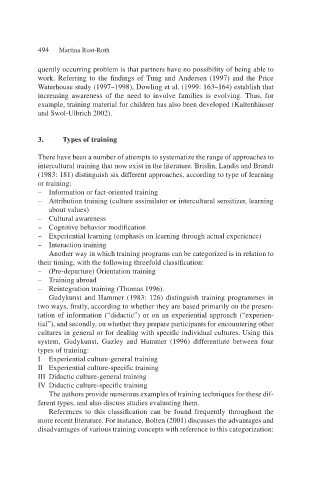Page 516 - Handbooks of Applied Linguistics Communication Competence Language and Communication Problems Practical Solutions
P. 516
494 Martina Rost-Roth
quently occurring problem is that partners have no possibility of being able to
work. Referring to the findings of Tung and Andersen (1997) and the Price
Waterhouse study (1997–1998), Dowling et al. (1999: 163–164) establish that
increasing awareness of the need to involve families is evolving. Thus, for
example, training material for children has also been developed (Kaltenhäuser
and Swol-Ulbrich 2002).
3. Types of training
There have been a number of attempts to systematize the range of approaches to
intercultural training that now exist in the literature. Brislin, Landis and Brandt
(1983: 181) distinguish six different approaches, according to type of learning
or training:
– Information or fact-oriented training
– Attribution training (culture assimilator or intercultural sensitizer, learning
about values)
– Cultural awareness
– Cognitive behavior modification
– Experiential learning (emphasis on learning through actual experience)
– Interaction training
Another way in which training programs can be categorized is in relation to
their timing, with the following threefold classification:
– (Pre-departure) Orientation training
– Training abroad
– Reintegration training (Thomas 1996).
Gudykunst and Hammer (1983: 126) distinguish training programmes in
two ways, firstly, according to whether they are based primarily on the presen-
tation of information (“didactic”) or on an experiential approach (“experien-
tial”), and secondly, on whether they prepare participants for encountering other
cultures in general or for dealing with specific individual cultures. Using this
system, Gudykunst, Guzley and Hammer (1996) differentiate between four
types of training:
I Experiential culture-general training
II Experiential culture-specific training
III Didactic culture-general training
IV Didactic culture-specific training
The authors provide numerous examples of training techniques for these dif-
ferent types, and also discuss studies evaluating them.
References to this classification can be found frequently throughout the
more recent literature. For instance, Bolten (2001) discusses the advantages and
disadvantages of various training concepts with reference to this categorization:

